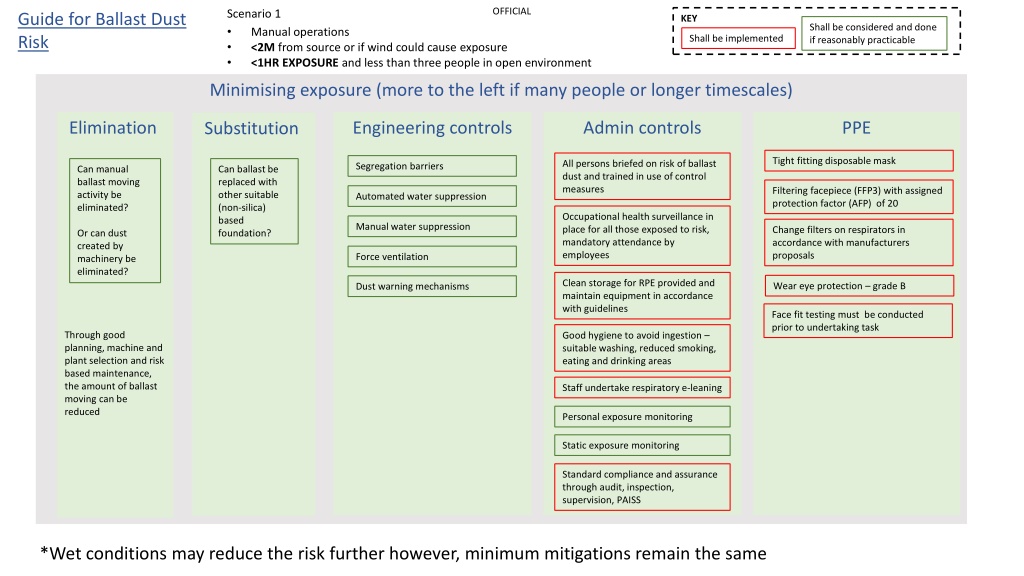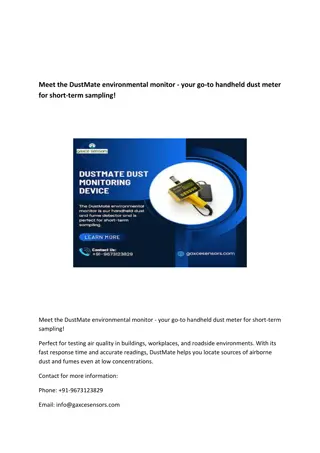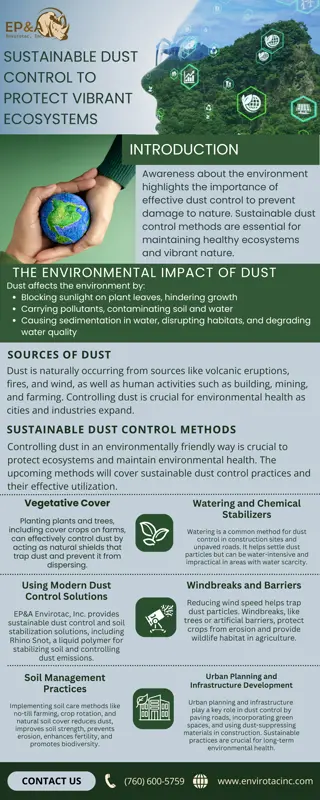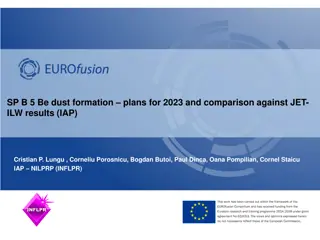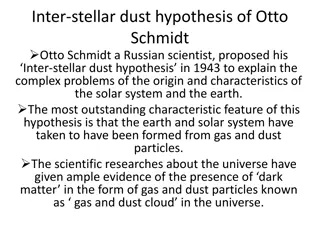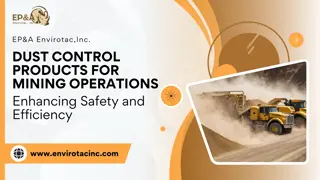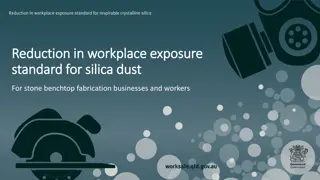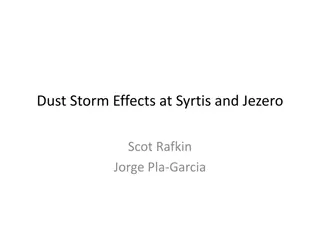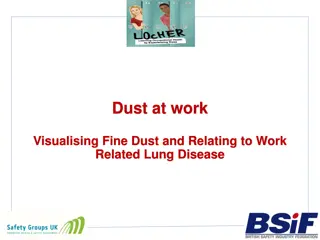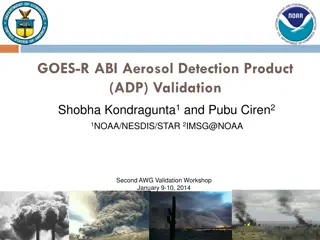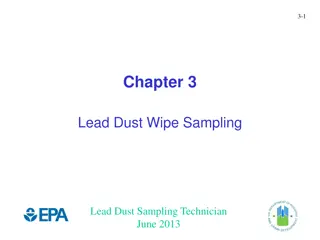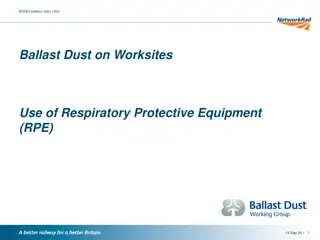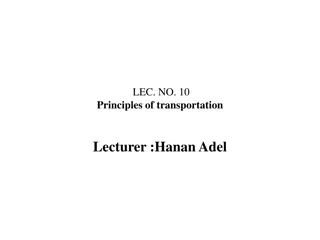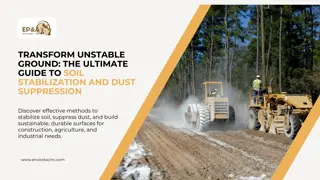Comprehensive Guide for Managing Ballast Dust Risks in Work Environments
This guide outlines detailed measures and protocols to effectively manage the risks associated with ballast dust exposure in work environments. It covers various aspects such as elimination, engineering controls, personal protective equipment, hygiene practices, and surveillance protocols to ensure a safe working environment where exposure to ballast dust is minimized and managed efficiently.
Download Presentation

Please find below an Image/Link to download the presentation.
The content on the website is provided AS IS for your information and personal use only. It may not be sold, licensed, or shared on other websites without obtaining consent from the author. Download presentation by click this link. If you encounter any issues during the download, it is possible that the publisher has removed the file from their server.
E N D
Presentation Transcript
OFFICIAL Scenario 1 Guide for Ballast Dust Risk KEY Shall be considered and done if reasonably practicable Manual operations <2M from source or if wind could cause exposure <1HR EXPOSURE and less than three people in open environment Shall be implemented Minimising exposure (more to the left if many people or longer timescales) Elimination Engineering controls Admin controls PPE Substitution Tight fitting disposable mask All persons briefed on risk of ballast dust and trained in use of control measures Segregation barriers Can manual ballast moving activity be eliminated? Can ballast be replaced with other suitable (non-silica) based foundation? Filtering facepiece (FFP3) with assigned protection factor (AFP) of 20 Automated water suppression Occupational health surveillance in place for all those exposed to risk, mandatory attendance by employees Manual water suppression Change filters on respirators in accordance with manufacturers proposals Or can dust created by machinery be eliminated? Force ventilation Clean storage for RPE provided and maintain equipment in accordance with guidelines Wear eye protection grade B Dust warning mechanisms Face fit testing must be conducted prior to undertaking task Through good planning, machine and plant selection and risk based maintenance, the amount of ballast moving can be reduced Good hygiene to avoid ingestion suitable washing, reduced smoking, eating and drinking areas Staff undertake respiratory e-leaning Personal exposure monitoring Static exposure monitoring Standard compliance and assurance through audit, inspection, supervision, PAISS *Wet conditions may reduce the risk further however, minimum mitigations remain the same
OFFICIAL Scenario 2 Guide for Ballast Dust Risk KEY Shall be considered and done if reasonably practicable Manual operations <2m from source or if wind could cause exposure >1HR EXPOSURE or/and more two people Shall be implemented Minimising exposure (more to the left if many people or longer timescales) Elimination Engineering controls Admin controls PPE Substitution All persons briefed on risk of ballast dust and trained in use of control measures Powered air respirator required with integral visor. FFP3 APF20 Segregation barriers Can ballast be replaced with other suitable (non-silica) based foundation? Can manual ballast moving activity be eliminated? Automated water suppression Occupational health surveillance in place for all those exposed to risk, mandatory attendance by employees Manual water suppression unless ballast is heavily wet due to weather conditions Or can dust created by machinery be eliminated? Maintenance and filter changes in accordance with manufacturers guidance and must be documented. Clean storage for RPE provided and maintain equipment in accordance with guidelines Dust warning mechanisms Wear eye protection GRADE B Forced ventilation Through good planning, machine and plant selection and risk based maintenance, the amount of ballast moving can be reduced Good hygiene to avoid ingestion suitable washing, reduced smoking, eating and drinking areas Staff undertake respiratory e- learning Personal exposure monitoring Static exposure monitoring Standard compliance and assurance through audit, inspection, supervision, PAISS *Wet conditions may reduce the risk further however, minimum mitigations remain the same
Scenario 3 OFFICIAL Guide for Ballast Dust Risk Control KEY Shall be considered and done if reasonably practicable Mechanical operations *DRY CONDITIONS <10m from source or if wind could cause exposure Shall be implemented Minimising exposure (more to the left if many people or longer timescales) Elimination Engineering controls Admin controls PPE Substitution Powered air respirator required with integral visor. FFP3 APF20 Exclusion zones in place All persons briefed on risk of ballast dust and trained in use of control measures Can ballast be replaced with other suitable (non-silica) based foundation? Can ballast moving activity be eliminated? Automated water suppression or if not possible then manual water suppression consider damping at source Occupational health surveillance in place for all those exposed to risk, mandatory attendance by employees Or can dust created by machinery be eliminated? Forced ventilation Tight fitting FFP3 where exposure is less than 1hour Dust warning mechanisms Clean storage for RPE provided and maintain equipment in accordance with guidelines Maintenance and filter changes in accordance with manufacturers guidance and must be documented. Protected OTP in cabs with forced air and HEPA filters Through good planning, machine and plant selection and risk based maintenance, the amount of ballast moving can be reduced Good hygiene to avoid ingestion suitable washing, reduced smoking, eating and drinking areas Vehicle windows to be closed at all times Face fit testing must be conducted for tight fitting face mask Staff undertake respiratory e-leaning Wear eye protection GRADE B Personal exposure monitoring Static exposure monitoring Standard compliance and assurance through audit, inspection, supervision, PAISS *Wet conditions may reduce the risk further however, minimum mitigations remain the same
Scenario 4 OFFICIAL Guide for Ballast Dust Risk Control KEY Shall be considered and done if reasonably practicable Mechanical operations wet conditions Less than 10m from source or if wind could cause exposure Shall be implemented Minimising exposure (more to the left if many people or longer timescales) Elimination Engineering controls Admin controls PPE Substitution All persons briefed on risk of ballast dust and trained in use of control measures Powered respirator required with integral visor if over one hour exposure otherwise RPE with assigned protection factor of least 40 FFP3 Exclusion zones in place Can ballast be replaced with other suitable (non-silica) based foundation? Can ballast moving activity be eliminated? Automated water suppression or if not possible then manual water suppression consider damping at source Occupational health surveillance in place for all those exposed to risk, mandatory attendance by employees Or can dust created by machinery be eliminated? Change filters on respirators in accordance with manufacturers proposals Forced ventilation Clean storage for RPE provided and maintain equipment in accordance with guidelines Face fit testing must be conducted Dust warning mechanisms Wear eye protection Protected OTP in cabs with forced air and filters Through good planning, machine and plant selection and risk based maintenance, the amount of ballast moving can be reduced Good hygiene to avoid ingestion suitable washing, reduced smoking, eating and drinking areas Staff undertake respiratory e-leaning Personal exposure monitoring Static exposure monitoring Standard compliance and assurance through audit, inspection, supervision, PAISS
Scenario 5 OFFICIAL Guide for Ballast Dust Risk Control KEY Must be considered and done if reasonably practicable Mechanical and manual operations in TUNNEL Applies to everyone in the tunnel Must be implemented Minimising exposure (more to the left if many people or longer timescales) Elimination Engineering controls Admin controls PPE Substitution Operating within exclusion zone - Powered air respirator required with integral visor. FFP3 APF20 All persons briefed on risk of ballast dust and trained in use of control measures Exclusion zones in place Can ballast be replaced with other suitable (non-silica) based foundation? Can ballast moving activity be eliminated? Automated water suppression or if not possible then manual water suppression consider damping at source Occupational health surveillance in place for all those exposed to risk, mandatory attendance by employees Or can dust created by machinery be eliminated? Force ventilation or full risk assessment including tunnel airflow analysis Operating outside of exclusion zone - Tight fitting FFP3 for maximum of 1hour Clean storage for RPE provided and maintain equipment in accordance with guidelines Dust warning mechanisms Maintenance and filter changes in accordance with manufacturers guidance and must be documented Protected OTP in cabs with forced air and HEPA filters Through good planning, machine and plant selection and risk based maintenance, the amount of ballast moving can be reduced Good hygiene to avoid ingestion suitable washing, reduced smoking, eating and drinking areas Vehicle windows to be closed at all times Face fit testing must be conducted Staff undertake respiratory e-leaning Wear eye protection GRADE B Personal exposure monitoring Static exposure monitoring Standard compliance and assurance through audit, inspection, supervision, PAISS *Wet conditions may reduce the risk further however, minimum mitigations remain the same
